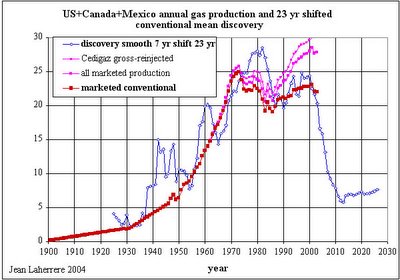Thursday, January 12, 2006
Thoughts on future home heating

How will we heat our homes tomorrow? North American natural gas discoveries are on the decline and production could fall off a cliff in the next five to ten years. The graph shows North American natural gas discoveries and production with the discovery curve moved forward 23 years. The area under the two curves will be equal once all the natural gas has been used. This is real data.
Importing natural gas as liquified natural gas (LNG) is the mainstream solution. But that gas would come from the Middle East and Russia, and it would be expensive. Our trade deficite would explode. Also we would need the infrastructure to import all that LNG. The most challanging are the LNG port facilities. They regularly explode and are very much unwanted by neighboring communities. The mainstream solution: off shore LNG ports in the Gulf of Mexico. But what about all those hurricanes? They will have a high likelihood of knocking out the gas lines that run from the LNG port to the mainland. Some Gulf of Mexico gas lines are still out from hurriance Katrina.
Also I argue that the natural gas should be used first for fertilizers. I wonder if we can feed the world's billions without fertilizers, natural gas chemicals, etc?
So if not natural gas than what?
Let us consider: coal, solar thermal, propane, passive cooling, passive solar, pellet stoves, corn stoves, wood stoves. Coal is dirty, bulky, emits carbon dioxide, etc. Solar thermal (or passive heating) can only augment heating needs in northern tier states. Propane prices will follow natural gas prices. Passive cooling will help maintain a lower summer indoor temperature – but people wanting a "cool" home may not be satisfied. The cost of the pellets for pellet stoves will tend to track the cost of the primary heating fuel (natural gas). Corn stoves will be competing for the corn against ethanol plants and hungry stomachs. Wood stoves, perhaps for the few, the hardy with wood lots.
What is left? Electricity. And what is the most efficient electric technology. Well for those of us in the Northern tier it would be Ground Source Heat Pumps (GSHP). GSHP happen to be very efficient at heating and cooling. And they work on mainstream homes in conventional neighborhoods.
Some homes GSHPs use over 10,000 kWhs per year. These I consider failures. However some use much less. Here are two examples:
A relatively small, 1320 ft2, home in Sun Prairie, WI. It is a tract home built to Wisconsin code. Over a period of three years of data collection, the home’s GSHP consumed an average of 2510 kWhs/year. This could be met by an unshaded 2 kW fixed-mounted solar electric system (requiring 200 ft2 of unshaded solar electric panels facing roughly south).
A larger home, 3000 ft2, located in Elk River MN (NW of Saint Paul) consumes 5260 kWh/year for its GSHP system. Again the home is fairly conventional and indoor temperature is kept a 71 in the winter and about 80 in the summer (see www.econar.com/casestudies/hurd.htm). Its GSHP’s electricity needs could be met by an unshaded 4 kW fixed-mounted solar electric system.
Both of these homes have low GSHP electricity consumption, yet their consumption could be further reduced if they were designed, built and operated in a very energy efficient manner.
So perhaps the future is Solar Electic Systems on the roof and GSHPs in the ground? Lets hope so.
No to Nukes!